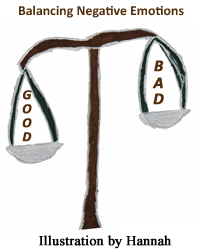
In my post last week, Negative Patterns, I pointed out that a negative emotion in childhood could become a pattern of response that could continue into his adulthood. I stressed that we, as caring adults, should develop a “watch and listen” approach so we can help a child prevent those negative emotions of responding to continue in his life.
This week I am writing about Good Negative Emotions. As my children’s illustrator and granddaughter, Hannah, would say, “Seriously?” “Yes, Hannah, seriously. There are times when each of these negative emotions should come into play in a positive way.”
For example:
GOOD ANGER: Good anger might include seeing another child being bullied. Their anger would allow them to go with the child to tell an adult rather than letting the bullying continue.
GOOD FEAR: Good fear helps a child to have a healthy sense of caution, such as fear of strange dogs and strange people, which can be dangerous for them.
GOOD WORRY: Good worry might include his grades in school. It is good to have a certain sense of worry or at least a deep feeling of concern in order to improve on study habits that will help keep his grades up to par.
GOOD GUILT: Good guilt comes from the conscience when having done something wrong. It can be a good thing, because it is a time to look at behavior that needs to be changed such as punching, fighting, or hurting others.
The key is for a caring adult to know when and how to balance the scales
between the bad and good negative emotions.
As I was writing this post, I was reminded of the Bible stories of Jonathan and David that Sunday School teachers tell children over and over, drawing on so many points that children can learn from them.
A brief refresher of one particular story to emphasize my point: Jonathan’s dear old dad, Saul, made a plan to kill David to prevent David from becoming king. It just so happened that Jonathan and David were best friends.
When Jonathan learned of this plot, he arose with fierce anger for he was sorry for what his father was going to do to his best friend, David. He then took positive action with his anger, and went out and warned David of this plot, which, of course, voided David’s pre-mature death from taking place by the hands of Saul. (1 Samuel 20)
I think the story clearly illustrates that Jonathan took the emotion of anger, which can produce severe consequences, and turned it into good anger for a positive result. That’s the reason, we as caring adults, should make it a point to help our children balance the scales between “bad and good” negative emotions.
Oh my dear friends, no one ever said it was easy trying to grasp all the things we should be teaching our children. But, I have to believe that most parents do the best they know how with the knowledge they have at the time.
Quite honestly, some of the things I know now about helping children, especially hurting children, I didn’t know when my own children were growing up, so I was out of touch with a lot of their hurt and pain. Apart from their forgiveness, the only redemption I have is passing on the things I have since learned in the event it will help other hurting children.
That’s why I felt compelled to publish my book, Helping Hurting Children: A Journey of Healing. Since feelings are the bulk of the grieving process, two chapters are devoted to teaching children about feelings.
Join Hannah and me next week when we tackle The Silent Voice of Pain.










Good to know especially since I’m now learning my ow daughters emotions at age 2 1/2!
Sorry, I am just now replying to this, but quite interestingly, I had a two year old at my house this week. I learned a lot about emotions from her.